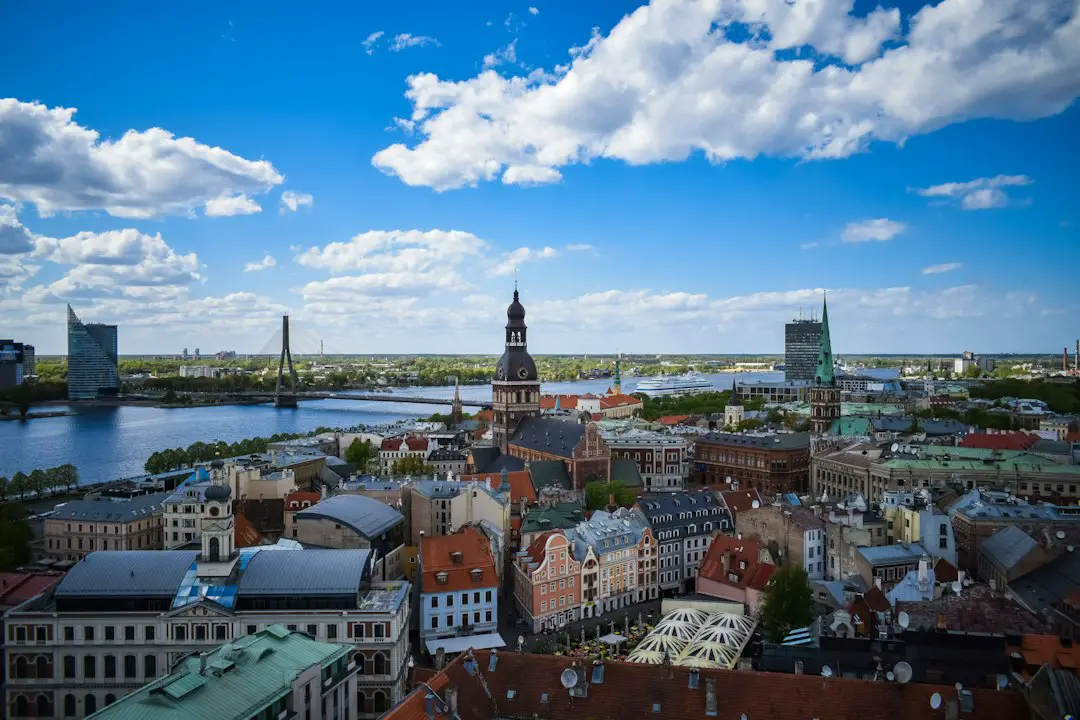
Ah, Riga – a city where every cobblestone seems to whisper tales of the past, and every building is a canvas showcasing centuries of architectural evolution. It’s a place where Gothic spires reach for the skies, Art Nouveau facades dazzle with intricate details, and Soviet-era structures stand as stoic reminders of a bygone era. Let’s take a stroll through the streets of Riga, Latvia, and unravel the rich tapestry of its architectural heritage.
The Dawn of Riga’s Architectural Journey
Founded in 1201, Riga’s architectural journey began with the construction of fortifications and religious buildings. The city’s oldest surviving stone structure, Riga Cathedral, stands as a testament to the city’s medieval roots. Its towering presence is a blend of Romanesque, early Gothic, and Baroque styles – a real mishmash that tells a story of the city’s evolving tastes and influences over the centuries.
Gothic Prowess and Hanseatic Influence
As a key member of the Hanseatic League, Riga flourished in the 13th to 15th centuries. The House of the Blackheads, originally built in the 14th century for the Brotherhood of Blackheads, a guild for unmarried merchants, shipowners, and foreigners, is a prime example of the city’s Gothic architecture. Its ornate façade and grandeur speak volumes about the wealth and power of Riga’s traders during this period.
Baroque and Classicism: A Touch of Opulence
Fast forward to the 17th and 18th centuries, and Riga’s architecture took on a more opulent turn. The Baroque style, with its dramatic details and grandiose scale, can be seen in structures like the Rundāle Palace. Classicism followed, bringing a sense of order and symmetry to Riga’s streets, best exemplified by the iconic Freedom Monument, which stands as a symbol of Latvia’s struggle for independence.
The Art Nouveau Movement: Riga’s Crowning Glory
But it’s the Art Nouveau movement that really put Riga on the architectural map. At the turn of the 20th century, the city underwent a construction boom, and architects like Mikhail Eisenstein (father of the famous filmmaker Sergei Eisenstein) left their indelible mark. The result? A staggering one-third of Central Riga’s buildings are Art Nouveau in style, making it one of the world’s richest repositories of this exuberant architectural form.
Soviet Era: Function Over Form
World War Ii and the subsequent Soviet occupation brought about a stark change in Riga’s architectural landscape. The emphasis shifted to functionality and mass housing, leading to the construction of utilitarian apartment blocks. These structures, often drab and monolithic, are a stark contrast to the ornate styles that preceded them.
Modern Times: A Blend of Old and New
Since regaining independence in 1991, Riga has been on a path of architectural rejuvenation. Contemporary structures, like the National Library of Latvia, stand alongside historic buildings, creating a skyline that’s a dialogue between the past and present. The city’s commitment to preserving its architectural heritage while embracing modernity is evident in every corner.
FAQs
- What is the most iconic example of Art Nouveau architecture in Riga?
The most iconic example would be the buildings along Alberta iela (Albert Street), where the flamboyant facades are adorned with sculptures, intricate stonework, and whimsical motifs.
- Can you visit the interiors of Riga’s historic buildings?
Yes, many of Riga’s historic buildings are open to the public, including the House of the Blackheads and several Art Nouveau museums that allow you to peek into the past.
- How has Riga’s architecture been preserved over the years?
Riga’s architecture has been preserved through a combination of government initiatives, UNESCO World Heritage status for the historic center, and active local and international preservation societies.
Conclusion
In conclusion, Riga’s architecture is a vivid chronicle of its history. From the medieval spires of the Riga Cathedral to the expressive Art Nouveau facades that line the city’s streets, each era has contributed to the city’s unique architectural identity. The Soviet period added a layer of simplicity and uniformity, which has since been complemented by modern developments that respect Riga’s past. This blend of old and new ensures that Riga’s skyline tells a story that’s as complex as it is beautiful.
For those of us who’ve wandered through Riga’s streets, the city’s architectural evolution isn’t just a matter of historical record; it’s a living experience. It’s the feeling of awe as you gaze up at an ornate Art Nouveau balcony, the sense of solemnity in the shadow of a Soviet block, and the spark of curiosity upon encountering a sleek new building. Riga’s architecture is more than just structures; it’s the soul of the city, ever-evolving and endlessly fascinating.
Whether you’re a real estate investor, a homeowner, or simply a lover of beautiful cities, Riga’s architectural journey is a compelling story of resilience, creativity, and the enduring power of place. So next time you’re in Latvia’s capital, take a moment to look up and around – you’re sure to be captivated by the layers of history etched into every building.